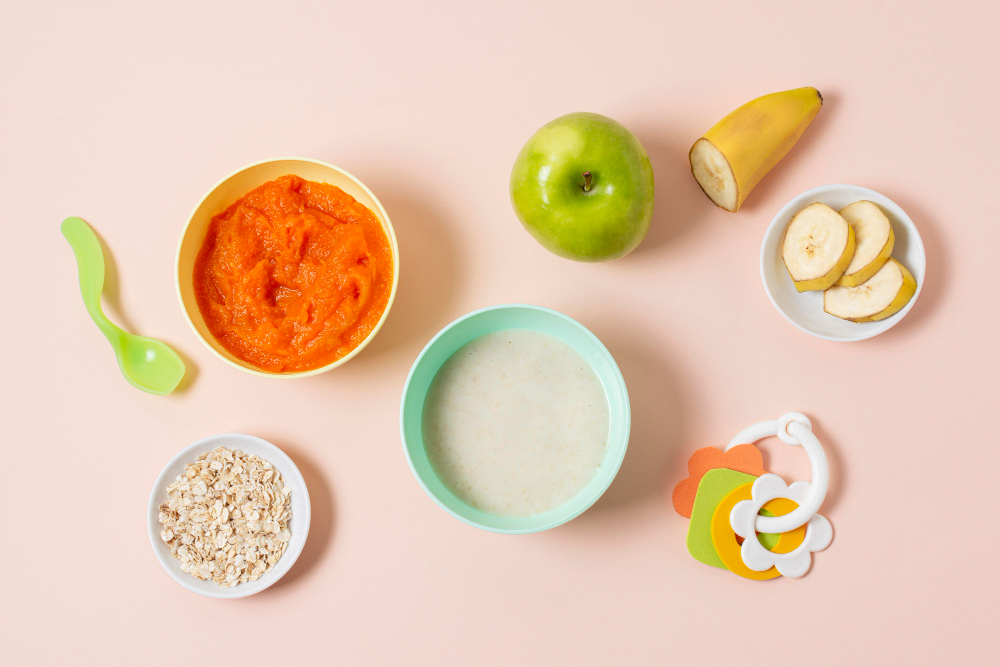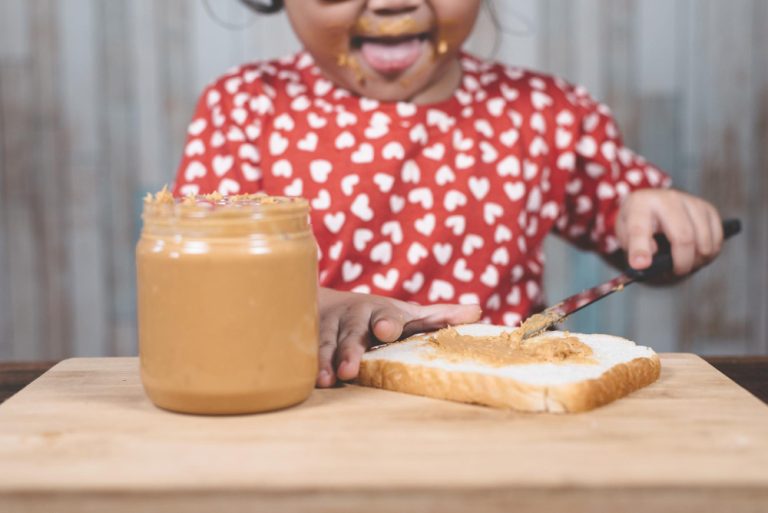When To Start Purees With Babies And How To Do It Right
Are you eagerly anticipating the exciting journey of introducing your little one to the world of solid foods? As a parent, witnessing this milestone is both exhilarating and nerve-wracking. Knowing exactly when to start purees with babies is essential for their development and overall health. Let’s delve into the intricacies of this pivotal phase to ensure a smooth transition for both you and your bundle of joy.
Undertake this culinary adventure with confidence, armed with the knowledge and tips to make your baby’s first puree experience a delightful and enriching one.
Introduction: When To Start Purees With Babies

When to start purees with babies and introducing purees to babies is a significant step in their journey of transitioning to solid foods. It not only helps them explore new tastes and textures but also provides essential nutrients for their growth and development. Starting purees at the right time is crucial to ensure that babies can safely and successfully navigate this important milestone.
When babies begin eating purees, they are exposed to a wide range of flavors and nutrients that complement their existing milk-only diet. Purees serve as a bridge between the familiar taste of breast milk or formula and the varied flavors of solid foods.
This gradual transition helps babies develop their taste preferences, chewing skills, and overall ability to consume a diverse range of foods.
At around 4 to 6 months of age, most babies start showing signs of readiness for purees. Some indicators include the ability to sit upright with support, good head control, and increased curiosity about what others are eating.
It’s important to note that every baby is unique, and readiness for solids may vary. Consulting with your pediatrician or healthcare provider can provide guidance tailored to your baby’s specific needs.
Introducing purees at the right time offers several benefits. It exposes babies to different tastes and textures, supporting their sensory development. Purees also provide essential vitamins, minerals, and nutrients that are crucial for their growth. Moreover, starting purees early can help prevent the development of picky eating habits later in life.
As we progress through this guide, we will discuss the recommended age range for introducing purees, signs of readiness, and practical tips for a smooth transition into the exciting world of solid foods. Let’s venture on a nutritious and enjoyable feeding journey for your little one!
When To Start Purees With Babies
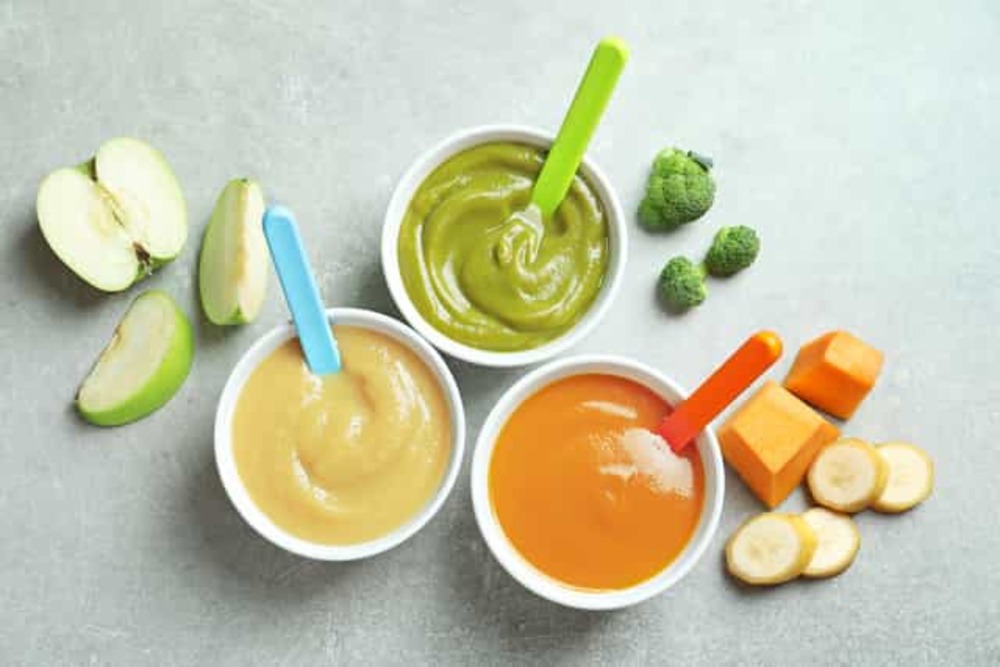
Introducing purees to babies is an exciting milestone in their journey of food exploration. It is important to know the right time to introduce purees to ensure a smooth transition from breast milk or formula to solid foods. The American Academy of Pediatrics recommends introducing purees around 4 to 6 months of age when babies show certain signs of readiness.
6 Signs Your Baby Is Ready for Purees

The introduction of purees to babies should be done at the right time when they are developmentally ready. Look for the following signs that indicate your baby is ready to start exploring solid foods:
1. Head and Neck Control
- Your baby should be able to hold their head steady and upright without support.
- This is crucial for safe and effective eating.
2. Sitting Up with Support
- Babies should be able to sit with some support, such as using a highchair or propped with cushions.
- This position helps them to swallow properly and reduces the risk of choking.
3. Increased Appetite
- If your baby is consistently hungry and seems unsatisfied with breast milk or formula alone.
- It may be a sign that they are ready to try purees and explore new tastes and textures.
4. Tongue Reflex
- The tongue-thrust reflex, where babies automatically push out anything placed on their tongue, usually diminishes around 4 to 6 months of age.
- This reflex needs to decrease for successful eating of purees.
5. Interest in Food
- Babies who show curiosity about what others are eating, reach for food or try to grab utensils during mealtime.
- It may be indicating their readiness to join in and explore new flavors.
6. Chewing and Mouthing Skills
- Babies start to develop the ability to move their tongue and jaw in a chewing motion, and they may enjoy mouthing toys or objects.
- These emerging skills are positive signs of readiness for purees.
Remember, every baby is unique, and it’s important to observe your baby’s behavior and consult with your pediatrician or healthcare provider before introducing purees. They can offer guidance based on your baby’s individual needs and provide professional advice tailored to their specific development.
As you begin the puree journey, keep in mind that starting solid foods is an exciting milestone, but it should be done gradually and with caution. Pay attention to any signs of allergies or adverse reactions and always introduce one new food at a time, allowing a few days before introducing another.
By watching for these readiness signs and adopting a patient and supportive approach, you can ensure a smooth introduction to purees and the world of solid foods for your little one.
Remember, each baby’s readiness for solids may vary. Always consult with your healthcare provider for personalized advice based on your baby’s unique needs and circumstances.
Introducing Purees: Step-by-Step
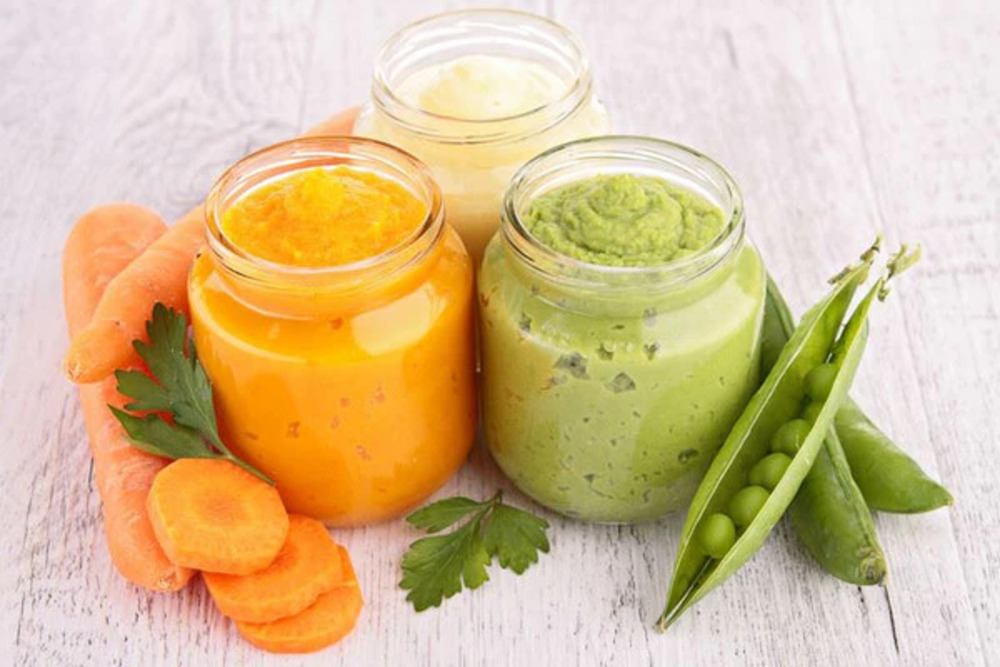
Once you have determined that your baby is ready for purees, it’s time to start the introduction. Here are some steps to follow:
1. Choose the Right Time
- Pick a time when your baby is calm, alert, and not overly hungry.
- Ideally, it’s best to introduce purees in the morning or early afternoon when your baby is well-rested and more likely to be receptive to new tastes and textures.
2. Start with Single-Ingredient Purees
- Begin with a single puree, such as mashed avocado or sweet potato.
- This allows your baby to gradually adjust to new flavors and textures.
3. Use Soft Utensils
- Opt for a small, shallow spoon or a soft-tipped feeding spoon to offer purees to your baby.
- Avoid using a bottle with a nipple, as this may interfere with the development of oral motor skills.
4. Go Slow and Follow Your Baby’s Cues
- Offer a small amount of puree on the tip of the spoon and gently touch it to your baby’s lips.
- Allow them to take the lead and open their mouth willingly.
- Don’t force-feed or rush the process.
- Let your baby explore the taste and texture at their own pace.
5. Gradually Increase Texture and Variety
- As your baby becomes more comfortable with purees, you can gradually increase the texture by adding some lumps or small pieces of soft food.
- Introduce a variety of fruits, vegetables, grains, and proteins to provide a well-rounded diet.
Remember to always closely monitor your baby during feeding and introduce new foods one at a time, waiting 3-5 days between each new introduction. This helps identify any potential allergies or sensitivities.
By recognizing the signs of readiness and following a step-by-step approach, you can ensure a positive and enjoyable experience for both you and your little one as they undertake their journey of solid foods.
Best First Foods for Baby Purees

Introducing your baby to purees is an exciting time as they begin their journey of exploring new tastes and textures. When it comes to choosing the best first foods for baby purees, it’s important to focus on introducing nutritious options that are easy to digest and unlikely to cause allergic reactions.
Here are some ideal choices to consider:
Fruits
- Avocado
Avocados are rich in healthy fats, fiber, and essential nutrients like vitamin C and potassium. Their smooth and creamy texture makes them perfect for introducing purees to your little one.
- Banana
Bananas are packed with potassium, vitamin C, and vitamin B6. They also have a natural sweetness that babies often enjoy. Mash or puree them for a smooth and easily digestible treat.
- Pears
Pears are gentle on the digestive system and provide a good source of fiber and vitamin C. Steam or bake them before pureeing to soften their texture.
Vegetables
- Sweet potatoes
Sweet potatoes are loaded with beta-carotene, vitamin A, and fiber. Steam or roast them until soft, then puree for a creamy and nutritious first food.
- Carrots
Carrots are rich in vitamin A and provide a slightly sweet taste. Boil or steam them until tender, then blend them into a smooth puree for your baby to enjoy.
- Peas
Peas are a great source of protein, fiber, and essential vitamins and minerals. Steam or boil them until soft and blend into a smooth puree for your little one.
Grains
- Oatmeal
Oatmeal is a nutritious and easily digestible grain for babies. Cook it with breast milk or formula to create a smooth and creamy consistency that is gentle on their developing tummies.
- Quinoa
Quinoa is a complete protein and contains essential amino acids. Rinse and cook it until soft, then puree to create a nutrient-rich meal for your baby.
- Brown rice
Brown rice is a good source of carbohydrates and provides energy for your little one. Cook it until soft and blend into a creamy puree for an easy-to-swallow meal.
Proteins
- Chicken
Cook chicken breast until thoroughly cooked and blend it with broth or water to create a protein-rich puree. Ensure it is fully pureed and free from any bones.
- Beans
Beans like black beans or lentils are an excellent source of plant-based protein and fiber. Cook them until they are very soft, and blend into a smooth puree.
Remember, when introducing new foods, it’s important to watch for any signs of allergies or intolerances. Start with small amounts and gradually increase the variety of foods to ensure your baby’s acceptance and tolerance. If you have any concerns or questions, consult your pediatrician for personalized guidance.
Progressing to More Complex Purees
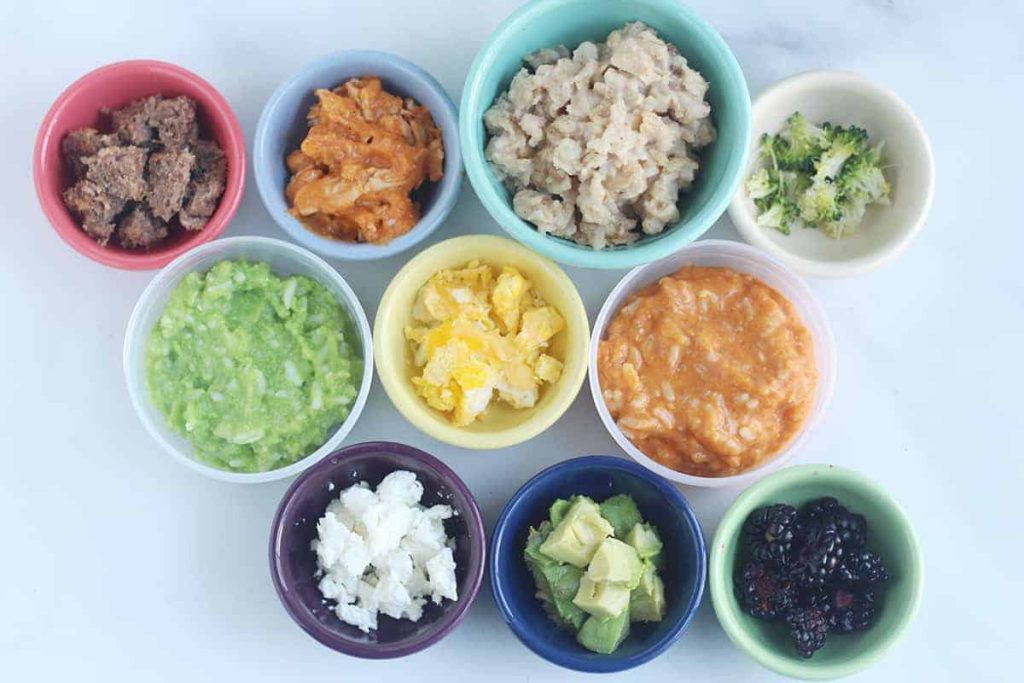
As babies grow and develop, it’s important to introduce them to a variety of textures and flavors to support their eating skills and preferences.
Here are some helpful tips on how to gradually progress to more complex purees:
1. Start with Smooth Purees
- Begin by offering smooth, single-ingredient purees to your baby.
- These can include pureed fruits like apples or pears, and vegetables like sweet potatoes or peas.
- Smooth purees provide a gentle introduction to new flavors and help babies get used to the different textures of solid foods.
2. Introduce Thicker Consistencies
- Once your baby is comfortable with smooth purees, you can gradually move on to thicker consistencies.
- Add a little bit of mashed banana or avocado to the puree to create a thicker texture.
- You can also try introducing mashed cooked grains like rice or oatmeal.
- Thicker purees help babies develop their chewing skills and encourage them to move their tongues in different ways.
3. Add Small Soft Pieces
- As your baby becomes more skilled at eating purees, you can start introducing small soft pieces of food alongside the purees.
- For example, you can offer small, well-cooked pieces of vegetables or soft fruits like diced steamed carrots or small bits of banana.
- This helps babies develop their hand-eye coordination and encourages self-feeding.
4. Explore Blended Textures
- Once your baby is comfortable with soft pieces of food, you can start exploring blended textures.
- This involves combining finely chopped or mashed foods with purees to create a more textured meal.
- For example, you can blend cooked vegetables with a thicker puree, or mash cooked beans into a smooth fruit puree.
- Blended textures help babies experience different flavors and develop their chewing skills further.
5. Offer Finger Foods
- As your baby progresses in their eating journey, it’s important to introduce finger foods.
- Finger foods encourage self-feeding and help babies refine their fine motor skills.
- Offer soft, safe finger foods like small pieces of cooked pasta, well-cooked vegetables, or small bits of cheese.
- Always supervise your baby during finger food meals to prevent choking hazards.
Remember, every baby is unique and may progress at their own pace. Pay attention to your baby’s cues and readiness for more complex purees. It’s important to have patience and gradually introduce new textures and flavors to ensure a positive and enjoyable feeding experience for your little one.
By gradually progressing to more complex purees, you’re supporting your baby’s eating skills and helping them develop a diverse palate. Enjoy this exciting phase of your baby’s food journey and have fun exploring different textures and flavors together!
Baby Food Introduction Chart
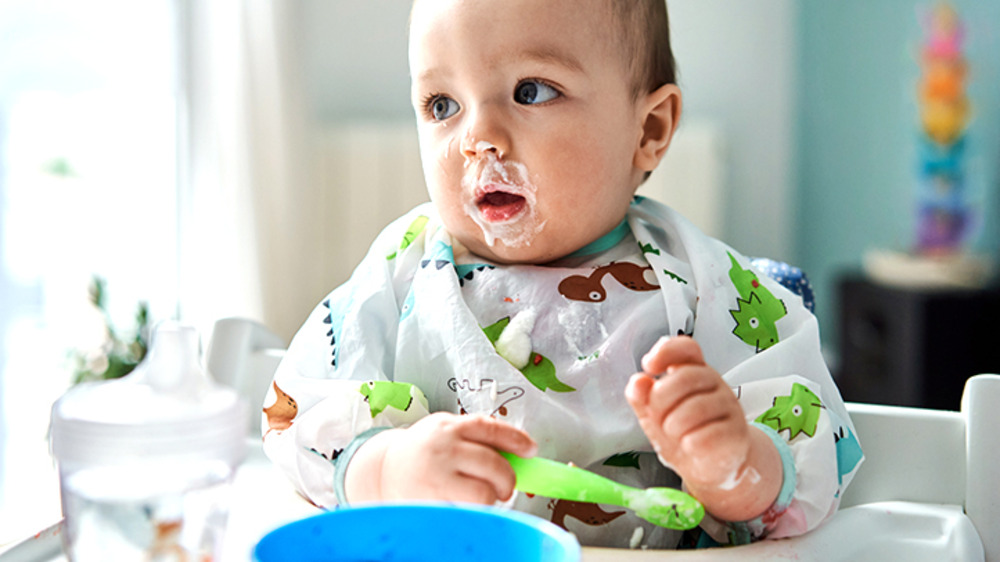
Introducing solid foods to your baby is an exciting and important milestone. It’s essential to know when to start and how to gradually incorporate new foods into their diet. This baby food introduction chart provides a helpful guide on when to introduce different types of purees and how to progress as your baby grows.
Age Recommendations
- 4-6 months
At this stage, your baby’s digestive system is developing, and they may show signs of readiness for solid foods. It is recommended to start with a single-grain cereal, such as rice or oatmeal, mixed with breast milk or formula.
- 6-8 months
As your baby grows and develops, you can gradually introduce pureed fruits and vegetables, such as pureed sweet potatoes, applesauce, or mashed bananas. Be sure to introduce new foods one at a time and wait a few days before introducing another to monitor for any allergic reactions.
- 8-10 months
Your baby’s palate is expanding, and you can introduce more variety in their purees. This is a good time to introduce pureed meats, such as chicken or turkey, as well as mashed peas, carrots, or squash.
- 10-12 months
By this age, your baby’s chewing skills are developing, and you can start introducing soft table food, including small soft pieces of fruits, vegetables, and well-cooked pasta or rice. You can also introduce soft whole-grain bread and full-fat yogurt.
Gradual Introduction
- When introducing new foods to your baby, remember to start with small amounts and gradually increase as they become more comfortable.
- Use a spoon or your finger to offer small tastes and observe their reaction.
It’s important to note that every baby is different, and it’s perfectly normal for some babies to take longer to adapt to new flavors and textures. Be patient and keep offering a variety of foods to help them develop a well-rounded palate.
Tracking Progress
- You can use this printable baby food introduction chart to keep track of when you introduced different types of purees and monitor your baby’s progress.
- This chart will help you ensure you are introducing a diverse range of foods.
- Follow a gradual progression that aligns with your baby’s developmental needs.
Remember, it’s always a good idea to consult with your baby’s healthcare provider or a registered dietitian for personalized guidance on introducing solid foods and meeting your baby’s nutrition needs.
The Final Note: When To Start Purees With Babies
Introducing purees to babies at the right time is crucial for their overall health and development. By offering appropriate solid foods, parents can provide essential nutrients and help babies develop healthy eating habits. Knowing when to start purees with babies and how to do it right can help you choose the right practices for your baby’s eating development.
Starting solid foods at around 6 months of age, as recommended by the American Academy of Pediatrics, allows babies to gain necessary head control, tongue and swallowing skills, and show signs of readiness for solid foods.
Physical indicators like the ability to sit up with support, as well as developmental cues such as showing curiosity about food and the loss of the tongue-thrust reflex, indicate that a baby is ready to try purees.
When introducing purees, it is important to start with single-ingredient, smooth and pureed foods. Gradually offer a variety of fruits, vegetables, grains, and proteins to expose babies to different flavors and textures. This helps them develop a diverse palate and promotes acceptance of a wide range of foods.
By progressing to more complex purees and eventually introducing soft table foods, babies will develop their chewing skills and expand their food repertoire. Along the journey, it’s important to address common concerns like allergies and choking hazards.
Remember, always consult with your baby’s healthcare provider for personalized guidance. Introducing purees at the right time establishes a solid foundation for a lifetime of healthy eating habits and sets the stage for optimal growth and development.
Stay tuned for more informative articles and resources on baby nutrition and feeding guidelines!
FAQs: When To Start Purees With Babies
Starting purees with your baby can be an exciting yet daunting experience. As a parent, you want to ensure you make the right choices and address any concerns that may arise. Here, we will address some common questions and concerns related to starting purees, including allergies, choking hazards, and baby-led weaning.

